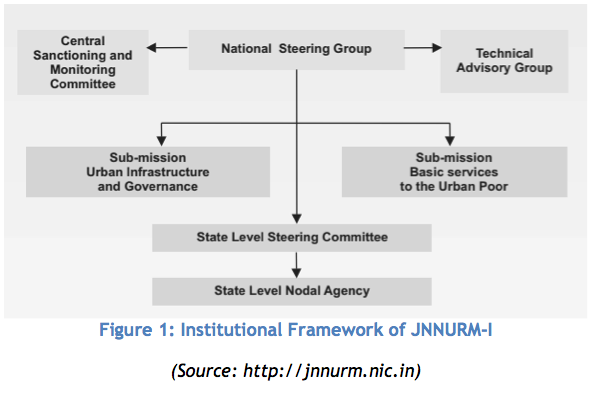By Vaibhav Anand, IFMR Capital
This post, along with the next one, provides a brief overview of the JNNURM-I, key lessons learnt from the mission and the proposed structure of the next phase of the Mission, JNNURM-II
JNNURM-I: Introduction
Jawaharlal Nehru Urban Renewal Mission-I (JNNURM-I or the Mission), launched by the government of India in December 2005, was the largest, and first if its kind, mission-led urban development initiative with an estimated provision of Rs. 50,000 crore. The initial duration of the Mission was seven years beginning from the year 2005-06i.
JNNURM-I aimed to encourage reforms and fast track planned development of identified citiesii. The Mission identified 65 cities/urban agglomerations (UAs), called ‘mission cities’, which were eligible for assistance for infrastructure development. A list of mission cities and the selection criteria is available on the Mission’s website (http://jnnurm.nic.in/). The main aim of the Mission was to promote reforms in urban governance and service delivery and provide reform-linked financial assistance for the planned infrastructure development of the mission cities.
Mission and Institutional Framework
JNNURM-I comprised two sub-missions which focussed solely on the 65 mission cities:
(a) Urban Infrastructure and Governance (UIG) administered by the Ministry of Urban Development (MoUD)
(b) Basic Services for Urban Poor (BSUP) administered by the Ministry of Urban Employment and Poverty Alleviation, now known as Ministry of Housing and Urban Poverty Alleviation (MoHUPA)iii
Further, the Mission had two sub-schemes: (i) Urban Infrastructure Development Scheme for Small and Medium Towns (UIDSSMT), and (ii) Integrated Housing and Slum Development Programme (IHSDP) which focused on all urban centres under the discretion of the state governments.

Going bottom-to-top, the State Level Nodal Agencies (SLNA) were responsible for inviting and appraising the projects before recommending to the State Level Steering Committee. Further, the financial assistance for the sanctioned projects was to be disbursed to the ULBs through SLNAs. They also had responsibility to manage and monitor the performance of the projects and reform implementation under the Mission. At state level, the project proposals were reviewed and prioritised by the State Level Steering Committee.
At the central level, there were two project appraisal bodies: the Technical Advisory Group (TAG) and the Central Sanctioning and Monitoring Committee (CSMC). National Steering Committee, chaired by the minister of UD and co-chaired by the minister of HUPA, provided the overall policy oversight and guidance.
Mission Strategy
JNNURM envisaged achieving the objectives of reform-linked planned urban development through the following strategy:
a) Formulation of the City Development Plan (CDP) by each mission city: The CDP was expected to be an integrated vision document for the cities which would include the policies, reform programmes and strategies, and financial plans. Infrastructure projects for the cities were to be identified based on the CDPs.
b) Preparation of the Detailed Project Report (DPR): The ULBs/parastatals were required to prepared DPRs for all the projects identified based on the CDPs. The DPRs would ensure that projects were well planned. The DPRs were expected to have details on the financial and operational viability and the environmental impact of the project among other things.
c) JNNURM Assistance and Leveraging of Funds: Financial assistance, in terms of grant or loans, from the central and state governments was to be provided to the ULBs through designated SLNAs. Further, it was expected that the nodal agencies and ULBs/parastatals would leverage these funds through external borrowings on the basis of credibility built on the financial and governance reforms under JNNURM.

Eligible Sectors and Projects
A comprehensive list of the sectors and projects eligible to receive assistance under the two submissions (UIG and BSUP) is available at the Mission website. Key sectors and projects included water supply and sanitation, solid waste management, urban transportation, development of slums, and projects to ensure basic services to the urban poor.
Reforms under the Mission
JNNURM-I was designed as a reform-linked investment mission to ensure the financially sustainable development of the urban centres through efficient governance, better infrastructure and improved service delivery. The Mission led a significant import on reform agenda which is divided into mandatory and optional reforms.
Key mandatory reforms were:
• Adoption of accrual based double entry accounting system by all ULBs
• Property tax reforms at ULB level(collection efficiency to at least 85% by 2012-13)
• Implementation of the 74th Constitutional Amendment Act by the state
• Repeal of Urban Land Ceiling and Regulation Act (ULCRA) and Rent Control Act
• Rationalization of Stamp Duty
A comprehensive list of the mandatory and optional reforms is available at the Mission website.
(Next post will discuss the current status of reforms and projects under JNNURM-I, key lessons from the Mission, and the proposed structure of JNNURM-II)
—
i – JNNURM-II has proposed a transition period two years in addition to the original tenure of seven years to complete the existing projects and to implement the reforms mandated under JNNURM-I
ii – Source: JNNURM Overview available at (http://jnnurm.nic.in/wp-content/uploads/2011/01/PMSpeechOverviewE.pdf)
iii – A series of fissions and fusions led to the current structure of MoUD and MoHUPA. http://mhupa.gov.in/ministry/index2.htm provides an interesting read on this
